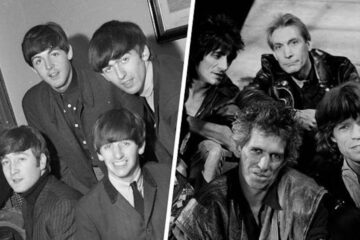News Five songs by The Beatles written under the influence of drugs
It’s an open secret that The Beatles experienced with drugs. If plotted on a graph, there would be a direct correlation between the group’s experimentation and intake increase, which undeniably went hand in hand. As the substances altered their mind, they opened them to newer and bolder sounds, changing rock and roll forever, one tab at a time.
But let’s not glorify it. The Beatles were relatively lucky when it came to their habits in that the four members got out unscathed while so many of their peers were taken too early from overdoses. While drugs helped the band’s music expand, they also became a detriment to their personal relationships. As LSD and weed turned to heroin, John Lennon and Paul McCartney’s friendship was never the same again, meaning that their professional relationship needed to adapt too, becoming sadly less collaborative.
However, in the mid to late 1960s, as the group would trip together, it was a moment of heightened creativity. With the acid, their new interest in spirituality and their travels around the world, especially to India, their lifestyle opened them up to sounds far more expansive than their earlier suited-and-booted rock and roll.
The topic also found its way into their lyrics. Plenty of the Beatles’ sounds continue secret messages or double meanings, hinting at their psychedelic adventures while trying not to be too obvious and upset their more conservative listeners. Buried in double entendres and dual meanings, the subject became a regular one. But what about the songs that were literally born out of trips? What about the tracks that were written or recorded as the band were under the influence? Well, these five tracks show the varied degrees of success that they brought.
The Beatles songs influenced by drugs:
‘The Word’
While it’s the band’s later albums that are most typically associated with drugs, they actually started a lot earlier. Rubber Soul was the origin of this era, as the group began smoking weed in 1964 after a meeting with Bob Dylan. When making the 1965 record, the Fab Four wrote their first songs under the influence.
‘The Word’ was the first. “We smoked a bit of pot, then we wrote out a multicoloured lyric sheet, the first time we’d ever done that,” McCartney said of the process. “We normally didn’t smoke when we were working. It got in the way of songwriting because it would just cloud your mind up – ‘Oh, shit, what are we doing?’ It’s better to be straight. But we did this multicoloured thing.”
However, the experience seemed to open up a door. Not only would they go on to write plenty more tracks under the influence of much heavier substances, but the pot seemed to make the writers philosophical. “It sort of dawned on me that love was the answer, when I was younger, on the Rubber Soul album,” Lennon once said, tracing his ‘Imagine’ philosophy back to this track. “My first expression of it was a song called ‘The Word’. The word is ‘love.’”
‘Tomorrow Never Knows’
After Rubber Soul came Revolver, a further step into the band’s drug habit and the introduction of hallucinogenics. John Lennon and George Harrison first tried LSD in 1965, pretty quickly introducing it to the rest of the band as a favoured new pastime. But they weren’t the only ones. The mid-1960s countercultural scene was absolutely obsessed with the drug as acid tests were being held and documented by the likes of Tom Wolfe, tying the links between LSD, art and music together tightly.
Lennon became especially fascinated with the topic, basing this track on his findings in the book The Psychedelic Experience: A Manual Based on the Tibetan Book of the Dead. Following the instructions set out in the book, the musician went home, dropped acid and meditated, emerging with this trippy track. Merging drugs and spirituality, LSD became an essential piece of his new philosophy, turning to it to open and expand his mind. The opening lyrics, “Turn off your mind, relax, and float downstream,” serve as instructions for finding his creative centre.
‘Getting Better’
More so than any other album, Sgt Pepper’s Lonely Hearts Club Band feels like the group’s drug-taking opus. Made with an essentially limitless budget and no deadline, stories of the sessions have become infamous as a gathering place for the era’s top talents, biggest names and trippiest parties.
They could have been lethal, though. When it came to recording ‘Getting Better’, they were one misstep away from tragedy. While working on the song, Lennon started to complain of feeling unwell after taking something. “I thought I was taking some uppers,” he said. “I thought I felt ill. I thought I was going cracked. Then I said, ‘I must get some air.’ They all took me upstairs on the roof, and George Martin was looking at me funny.”
Leaving him to return to the sessions, the rest of the band rushed up to retrieve their friend as it hit them all at once. “It dawned on me. I must have taken acid,” Lennon explained. A close call for a potential end to it all if he’d tripped his way off the roof. Instead, they went back into the studio and finished the song.
‘It’s All Too Much’
Out of all the members, George Harrison was especially interested in hallucinogenics. Going hand in hand with his keen interest in Indian culture and music, meditation and the Maharishi, LSD was simply another part of his mission for enlightenment.
In 1969, for their Yellow Submarine album, Harrison took a trip and penned an ode to his favourite pastime. “‘It’s All Too Much’ was written in a childlike manner from realisations that appeared during and after some LSD experiences and which were later confirmed in meditation,” he said of the track.
Capturing the energy of an acid trip as all the colours and patterns of the world are turned up to a maximum, the lyrics reflect the overload, singing, “It’s all too much for me to take/ The love that’s shining all around here/ All the world’s a birthday cake/ So take a piece but not too much.”
‘I Am The Walrus’
If there had to be one Beatles track picked out as the ultimate representation of the band’s drug habits, it might be ‘I Am The Walrus’. From the endlessly trippy record, Magical Mystery Tour, the track is absurd from start to finish. Considered to be their most surreal lyrical effort, its meaning has been debated over and over.
But it simply might not be that deep as it was revealed that Lennon penned the track over the course of two acid trips. “The first line was written on one acid trip one weekend. The second line was written on the next acid trip the next weekend, and it was filled in after I met Yoko,” he said of the song.
As drugs became a major pillar in his life, so did the very idea of surrealism. “Surrealism had a great effect on me because then I realized that the imagery in my mind wasn’t insanity; that if it was insane, I belong in an exclusive club that sees the world in those terms,” he said. “Surrealism to me is reality. Psychic vision to me is reality.”




